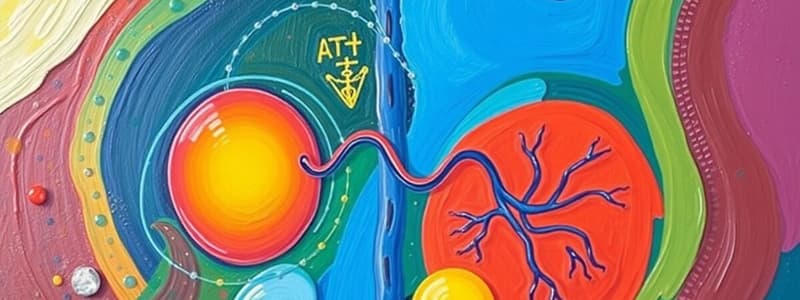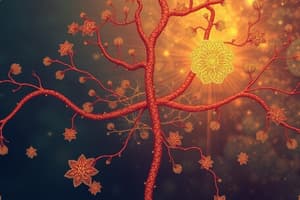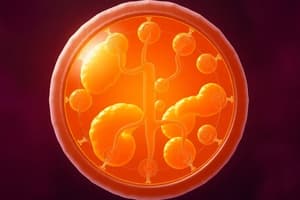Podcast
Questions and Answers
What is the primary role of ATP in cellular respiration?
What is the primary role of ATP in cellular respiration?
- To transport oxygen within the cells
- To serve as a store of unused food energy
- To power cellular functions and activities (correct)
- To initiate cellular digestion
Which part of cellular respiration generates the highest amount of ATP?
Which part of cellular respiration generates the highest amount of ATP?
- Calvin cycle
- Glycolysis
- Electron transport chain (correct)
- Krebs Cycle
Where does the majority of cellular respiration take place within the cell?
Where does the majority of cellular respiration take place within the cell?
- The ribosomes
- The mitochondria (correct)
- The nucleus
- The endoplasmic reticulum
Which of the following processes is NOT part of cellular respiration?
Which of the following processes is NOT part of cellular respiration?
What type of action within muscle fibers is powered by ATP?
What type of action within muscle fibers is powered by ATP?
Flashcards
Cellular Respiration
Cellular Respiration
The process where cells release energy from food and store it as ATP, a usable energy source.
ATP
ATP
Adenosine triphosphate; the cell's energy currency, powering various cellular functions.
Cellular Respiration Stages
Cellular Respiration Stages
Glycolysis, Krebs Cycle, and Electron Transport Chain (ETC) are the three main stages of cellular respiration.
Location of Cellular Respiration
Location of Cellular Respiration
Signup and view all the flashcards
ATP Use Examples
ATP Use Examples
Signup and view all the flashcards
Study Notes
Cellular Respiration
- Cellular respiration is the process cells use to extract energy from food.
- It's a series of controlled chemical reactions.
- These reactions release energy from food and store it as ATP, a usable energy source.
- Each step in the process produces both ATP and a molecule needed for the next step.
- ATP is like the cell's energy batteries, powering all its functions.
Chemistry of Cellular Respiration
- Glycolysis starts with glucose and ends with pyruvic acid.
- Glycolysis produces ATP, the cell's energy currency.
- The Krebs cycle begins with pyruvic acid and produces GTP and NADH.
- GTP is an energy currency similar to ATP.
- NADH is a "storage battery" carrying high-energy electrons from pyruvic acid.
- The electron transport chain (ETC) produces most of the ATP.
- The ETC uses high-energy electrons from NADH.
- The ETC creates an electron flow that activates an enzyme making ATP.
Recap Questions and Answers
- What process transforms food energy into usable energy? Cell respiration.
- Which part of cellular respiration produces the most ATP? The electron transport chain.
- Where does most cellular respiration take place in a cell? The mitochondria.
ATP Use
- ATP powers muscle contractions.
- It helps maintain homeostasis (body balance).
- ATP is necessary for movement.
- ATP fuels various cellular activities.
Moving Muscles
- Muscle fibers contract in response to nerve signals.
- The sliding action of filaments is driven by ATP.
- Muscles consist of parallel organized muscle filaments made of actin and myosin.
- These filaments are arranged in units called sarcomeres.
Studying That Suits You
Use AI to generate personalized quizzes and flashcards to suit your learning preferences.




